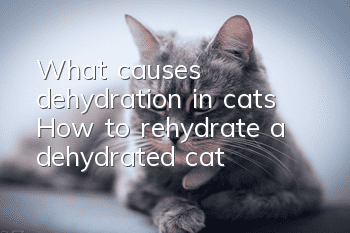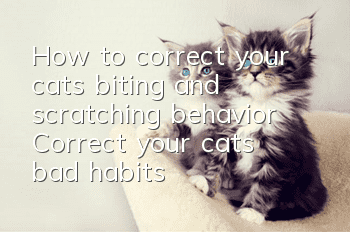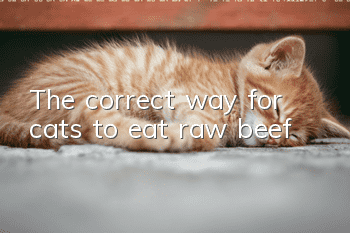What causes dehydration in cats? How to rehydrate a dehydrated cat

Causes of dehydration in cats
Water is not only an important substance for sustaining life, but it also plays a key role in regulating the body's body temperature. Therefore, it is very dangerous for cats to suffer from dehydration. Mild dehydration may not have much impact on cats, but severe dehydration may threaten the life of cats.
There are two common causes of dehydration
1. Reduced water intake:
1. Animals consume less food and water
2. Animals suffer from systemic diseases, and the appetite and drinking centers are suppressed
2. Increased body water loss:
1. Polyuria caused by different causes
2. Vomiting or diarrhea
3. Increased respiratory rate or wheezing caused by high fever
4. Extensive skin damage or burns
5. Pleural effusion, ascites or gastrointestinal effusion
What are the types of cat dehydration?
The so-called dehydration is a manifestation of the loss of body water greater than the intake, and according to the different nature of dehydration, it can be divided into simple water loss and electrolyte loss of body fluids. After dehydration, dehydration is divided into three types according to the amount of sodium ions in the extracellular fluid: hypertonic dehydration, hypotonic dehydration and isotonic dehydration.
1. Hypertonic dehydration: high plasma sodium and high osmotic pressure, intracellular fluid leaks out, intracellular dehydration, and extracellular fluid volume usually decreases very little, so hematocrit and plasma protein change little . Hypertonic dehydration is seen in hypernatremia, diarrhea, vomiting, sweating, gastrointestinal obstruction, inability to drink water, poisoning and shock.
2. Hypotonic dehydration: The loss of sodium ions in the body is greater than the loss of water, resulting in low plasma sodium and low osmotic pressure. In order to balance the osmotic pressure of extracellular fluid and intracellular fluid, cells absorb water from the extracellular fluid, which further enhances dehydration, reduces blood volume, increases hematocrit and plasma protein values, and makes animals less thirsty and prone to severe hypotension. Volumetric shock. Hypotonic dehydration is seen in severe vomiting, chronic bleeding, water retention in the body, hyperlipidemia, etc.
3. Isotonic dehydration: sodium ions and water in the body are lost in proportion, plasma sodium ion concentration and osmotic pressure are normal, and water in the extracellular fluid and intracellular fluid does not absorb each other. At this time, the hematocrit and plasma protein values No changes. Isotonic dehydration is seen in the loss of gastrointestinal secretions, plasma, and thoracic and ascites fluid.
How to determine the amount of dehydration in a cat
Depending on the amount of dehydration in cats, the treatment methods are also different, so how to judge the amount of dehydration in cats is also more important.key problem. If not handled properly, it will make the situation worse, so be sure to pay attention to this.
There are many ways to estimate the amount of dehydration in the body:
1. Investigate the medical history to estimate the amount of dehydration: Ask the animal owner about the animal’s water consumption and appetite, the water loss after the onset of vomiting, diarrhea, polyuria, wheezing, salivation, etc., as well as the duration.
2. Weigh the weight: Compare the weight of the dog and cat before and after the disease to determine the amount of dehydration. However, it is difficult for most animal owners to tell the exact weight of their animals before illness, so it is difficult to compare.
3. Clinical symptoms: The previous accumulated dehydration can be judged from the mental state of the affected dogs and cats, wet and dry mucous membranes, sunken eyeballs, skin elasticity, capillary refill time and shock.
Generally, the amount of dehydration is less than 5% of body weight, and there is no obvious clinical manifestation of dehydration; when dehydration reaches 12% to 15% of body weight, shock and even death will occur.
How to rehydrate a dehydrated cat
When a cat is dehydrated to a certain extent, we must rehydrate it, and the methods used will vary depending on the urgency and severity of the situation. Below we will introduce the rehydration methods used in different situations.
1. Oral rehydration: suitable for chronically ill animals that are not seriously ill and do not vomit after oral administration. If the sick animals show severe vomiting, diarrhea, and rapid and large loss of body fluids, intravenous infusion should first be used to replenish the cumulative loss, and then oral replenishment of continued loss and maintenance of fluids should be performed. In addition to oral rehydration, oral rehydration can also be given through a nasogastric tube, pharyngeal esophagus, or gastrostomy. Supplementary fluids may also contain nutrients or hypertonic fluids.
2. Subcutaneous rehydration: Suitable for dogs and cats that are mildly dehydrated or do not like to eat. You can choose to rehydrate in areas with loose skin on the neck or back. The supplement is isotonic or slightly hypotonic liquid, but the isotonic 5% glucose solution cannot be injected subcutaneously. Each point can inject 30 to 50 mL of liquid.
3. Intravenous rehydration: suitable for sick animals with severe dehydration or vomiting. Intravenous infusion can control the input speed, quickly replenish a large amount of fluid, and easily replenish the required amount of fluid accurately. Isotonic, hypertonic, hypotonic or irritating liquids (such as calcium chloride solution) can be injected intravenously. The injection site can be the jugular vein, the brachiocephalic vein of the forelimb, the saphenous vein of the hindlimb or the femoral vein.
4. Intraperitoneal rehydration: suitable for rewarming severely dehydrated puppies and cats, and animals with hypothermia. Isotonic or slightly hypotonic fluids can be used for intraperitoneal rehydration, which must be warmed to body temperature before infusion. Because it easily causes peritonitis, it is rarely used clinically.
5. Intra-marrow rehydration: suitable for severely dehydrated kittens or small animals. At this time, the infusion blood vessels are deflated and intravenous infusion is difficult. Except for highly irritating liquids (such as calcium chloride solution), all liquids that can be injected intravenously, including bloodThe fluid can be input through the bone marrow. The input site can be the bone marrow of the femur, tibia or humerus.
6. Rectal infusion: Because the large and small intestines of dogs and cats are short, liquids and nutrients can be instilled through the rectum. The method is to raise the hindquarters and pour water and nutrients into the large and small intestines to facilitate absorption.
- How often should a cat that doesn’t go out need to be dewormed?
- If you think of food allergies as cat mites, beware of your cat becoming bald!
- What to feed a cat if there is no cat food?
- Why does a cat run away when it sees a mouse?
- Cats don’t drink water, here are some tips for cats who don’t like to drink water!
- What to do if an adult cat doesn’t poop for four days? What’s the reason why a cat doesn’t poop?
- How long does it take for a cat to have contractions to give birth to her first baby?
- Cat prompts owner to call before giving birth to kittens
- Why is there blood in the cat's vomit?
- What breed is a short-footed cat?



